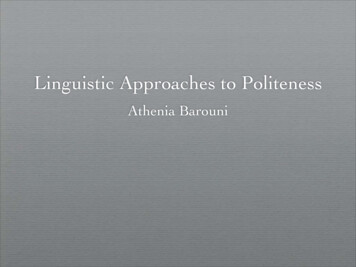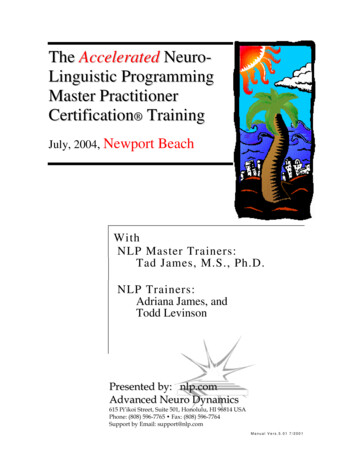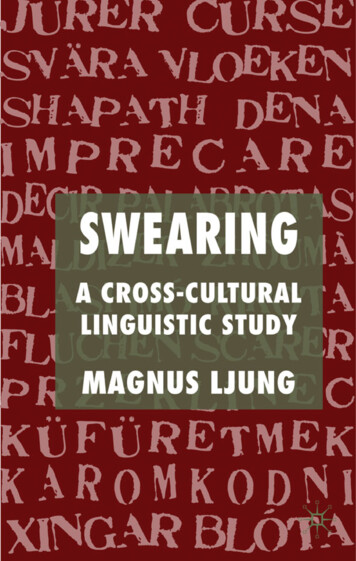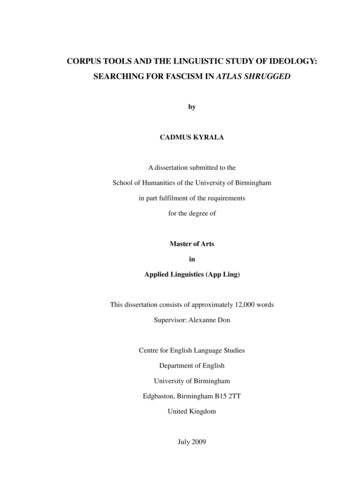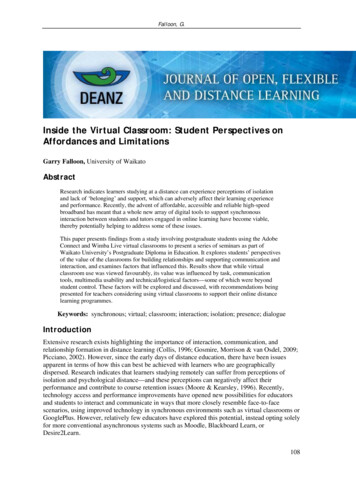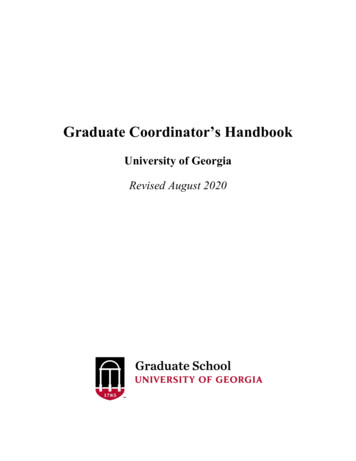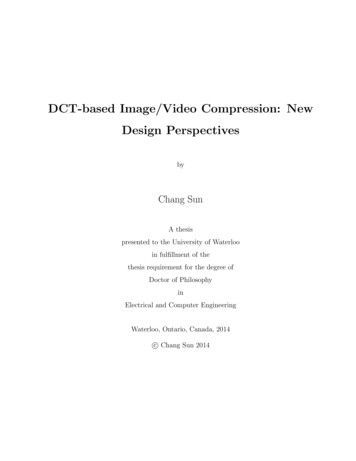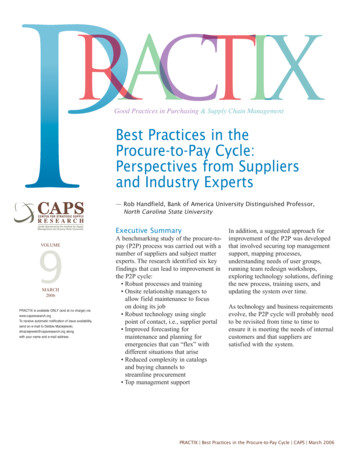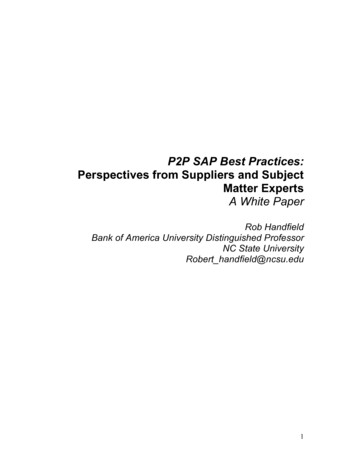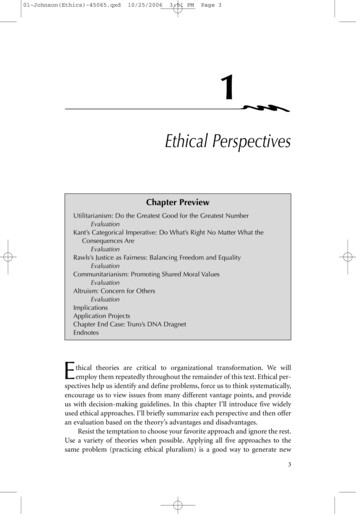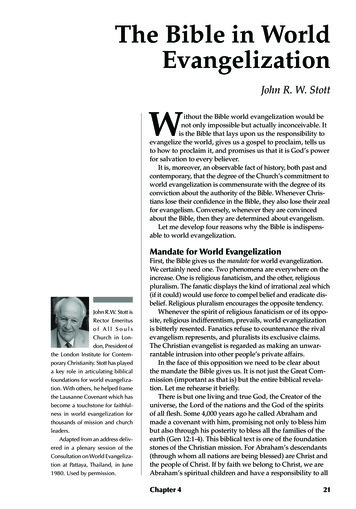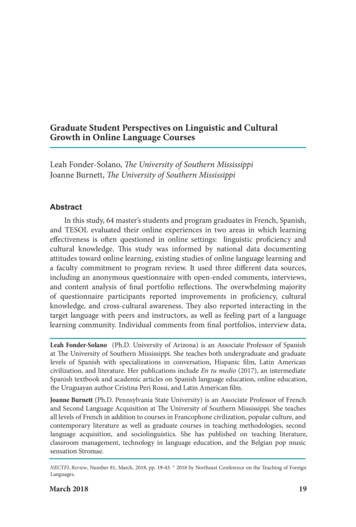
Transcription
Graduate Student Perspectives on Linguistic and CulturalGrowth in Online Language CoursesLeah Fonder-Solano, The University of Southern MississippiJoanne Burnett, The University of Southern MississippiAbstractIn this study, 64 master’s students and program graduates in French, Spanish,and TESOL evaluated their online experiences in two areas in which learningeffectiveness is often questioned in online settings: linguistic proficiency andcultural knowledge. This study was informed by national data documentingattitudes toward online learning, existing studies of online language learning anda faculty commitment to program review. It used three different data sources,including an anonymous questionnaire with open-ended comments, interviews,and content analysis of final portfolio reflections. The overwhelming majorityof questionnaire participants reported improvements in proficiency, culturalknowledge, and cross-cultural awareness. They also reported interacting in thetarget language with peers and instructors, as well as feeling part of a languagelearning community. Individual comments from final portfolios, interview data,Leah Fonder-Solano (Ph.D. University of Arizona) is an Associate Professor of Spanishat The University of Southern Mississippi. She teaches both undergraduate and graduatelevels of Spanish with specializations in conversation, Hispanic film, Latin Americancivilization, and literature. Her publications include En tu medio (2017), an intermediateSpanish textbook and academic articles on Spanish language education, online education,the Uruguayan author Cristina Peri Rossi, and Latin American film.Joanne Burnett (Ph.D. Pennsylvania State University) is an Associate Professor of Frenchand Second Language Acquisition at The University of Southern Mississippi. She teachesall levels of French in addition to courses in Francophone civilization, popular culture, andcontemporary literature as well as graduate courses in teaching methodologies, secondlanguage acquisition, and sociolinguistics. She has published on teaching literature,classroom management, technology in language education, and the Belgian pop musicsensation Stromae.NECTFL Review, Number 81, March, 2018, pp. 19-43. 2018 by Northeast Conference on the Teaching of ForeignLanguages.March 201819
NECTFL Review 81and the open response section of the questionnaire contextualize and elucidatethese findings.Introduction(Hall & Knox, 2009). Even those who may have generalOnline learningknowledge about online learning may distrust the formatorganizedor conflate very different online learning contexts and through learningpopulations (e.g., MOOCS vs. small-group academic coursesmanagement(Ko & Rossen, 2017). In fact, Inside Higher Ed (2014) publishedsystems hasbeen present ina national Gallup poll showing that only 33% of faculty believethat online courses can produce learning outcomes equivalent higher educationfor almostto those in-class; 83% of faculty respondents rate studenttwo decades.interaction in online courses as inferior to that of classroomNevertheless,based courses; and faculty in humanities (including foreign oruncertaintysecond language instructors) are generally the most skeptical; persists about its54% view online courses negatively.appropriatenessProfession-wide, it is accepted that learning takes place and even how orin face-to-face instruction. In online contexts, however, poll whether it works,results such as these Inside Higher Ed survey responses show particularly in thethat many still question whether meaningful learning can or field of languagelearning wheredoes take place online without regard for academic context,relatively fewinstructor qualifications, program level, or course set-up.studies have beenIndeed, during several years of teaching graduate languageconducted.courses online, the authors1 commonly encountered bothpointed and subtle critiques of online instruction particular to language learning,e.g., that online courses could not provide high-quality language or culturaldevelopment. These concerns regarding online learning did not match ourexperiences over a decade of combined administration and online instruction,nor did it reflect the experiences typically described in graduating students’ finalprogram reflections, such as the following comment:As far as improving my knowledge of the Spanish language, I can definitelysay that I was pushed and challenged academically in this area. It was soexciting to have opportunities to improve my knowledge as well as beingtaught with different tools like: service learning, watching films in thetarget language, and reading literature. It’s not to say that I didn’t alreadydo some of these things before, but I expanded upon them to reveal thenext level of learning a language. (Final Portfolio)As faculty in a well-established online Master of Arts in the Teaching ofLanguages program with concentrations in Spanish, French, and TESOL, theauthors decided to conduct a program review to gauge the experiences andperspectives of actual online language students and program graduates regardingtheir linguistic and cultural growth. This review identified commonly-voicedcritiques that could be attributed to online programs in general and to onlinelanguage teacher education in particular. For the purposes of this article, we explore20March 2018
Graduate Student Perspectives on Linguistic and Cultural Growthonly those categories associated with language learning: improvement in the fourskills (reading, writing, listening, speaking), interaction with peers and instructors,improvement in cultural knowledge and cross-cultural awareness, and participationin a community of language learners.This research adds to the literature because most of the studies (and positions)regarding online language learning to date address only lower-level learners inundergraduate populations (Hauk & Stickler, 2006; O’Dowd, 2011; Russell & Curtis,2013). In their review of language education programs via distance learning, Halland Knox (2009) call for more empirical studies that are both quantitative andqualitative in nature, grounded by the data, and triangulated by more than one datasource such as interviews, self-reported data, observation, or teacher collaboration.They also encourage a focus on languages other than English as a second language.We believe our study meets these requirements, as it uses a triangulated approachto look at language learning and language teacher education online. It offers insightfrom an anonymous questionnaire, student interviews, and content analysis of finalprogram reflections.Program context and instructional historyWhile the master’s program at The University of Southern Mississippi has alwaysoffered classes on campus, in 2008 an online option for year-round study replaceda summer intensive model. Since that time, the majority of master’s students haveenrolled exclusively online, with a small number (9-12) of on-campus students andgraduate teaching assistants taking a mix of traditional and online courses. Studentsmay enroll in Fall, Spring, or Summer sessions and take one or two courses onlineper session; for this reason, there are no traditional student cohorts except for oncampus teaching assistants. Online students are typically practicing teachers whotake five to six semesters to complete the degree. Graduate students in the programare required to take five core linguistics and education classes (second languageteaching methods, applied linguistics, second language acquisition, sociolinguisticsand culture, and a second/foreign language practicum completed in a school setting),along with five classes in their language emphasis and one elective of their choice. Asa final program assessment, they are required to create a professional portfolio thatincludes an open-ended reflection on their experience in the program.All the core courses in the program are taught by full-time tenured/tenuretrack faculty members who are content specialists in fields such as languageacquisition, applied linguistics, and teacher education. These faculty members teachthe language emphasis courses along with two other area specialists in literature andculture studies.Review of pertinent literatureDespite skepticism, online learning will continue to form part of highereducation in every field of study and continues to grow both at the researcher’sown institution and nationwide. During the period of our study, Allen and Seaman(2008) found that over 20% of US college students were taking at least one courseonline. In 2010 they documented a 21% annual growth rate for online enrollments,March 201821
NECTFL Review 81compared to only a 2% growth rate in college enrollments overall. By 2012, onlineenrollments had grown to comprise 33.5% of all undergraduate enrollmentsnationwide (Allen & Seaman, 2014). Studies cite economic, institutional, andadministrative pressures (Allen & Seaman, 2010) as well as demand from timepressed students for convenience, flexibility, and ease of access (Burnett & FonderSolano, 2016; Murphy, 2002; Russell & Curtis, 2013) as contributing factors to thisexplosive growth. Not surprisingly, the bulk of these reports reflect lower-level,undergraduate populations with multiple sections and large enrollments. But onlinecourses are offered at every level, including upper-level courses for the major andgraduate programs—particularly in graduate degrees that cater to working adults,such as ubiquitous online MBA or TESOL programs. Because online instructionrepresents the single largest growth area in higher education and is constantlyevolving in terms of tools and functionality, it is imperative to study how onlinelearning takes place in different contexts and with different student populations.With regard to language study, however, research on higher-level language learningand language teacher education is scant.Language learning onlineStudies that have explored online language learning have highlighted thedifficulties of documenting the effectiveness of this format in language acquisition.In 2015 the Modern Language Journal devoted a special issue to proficiencyoutcomes in online language courses, exploring issues such as the challenges ofevaluating proficiency (Blake, 2015; Rubio 2015), student outcomes and measuresfor success (Lin & Warschauer, 2015; Van Deusen-Scholl, 2015), and standards forprogram accountability in student outcomes (Doughty, 2015). Some researchers,like Doughty, lamented the lack of research using quantifiable, objective measures tosupport claims of online effectiveness (particularly for commercial products such asRosetta Stone or Pimsleur). Blake (2015), however, explains that for many studies ofonline language learning, research using so-called “objective” measures may not beeither possible or desirable. In particular, he makes the case thatusing the ACTFL Oral Proficiency Interview (OPI) to assess. for an onlineproficiency outcomes is inherently “messy,” with complicating graduate programfactors such as different instructors, different course set-ups, in which studentsdifferent levels, different curricula, different class formats, and do not all take theeven different standards for proficiency: “After all, seeking out same courses, docomparative student outcomes between in situ and online not complete theprogram withinlanguage courses might constitute a reasonable exercise if thethe same timeprofession actually knew how to measure rigorously, or even frame, and woulddefine, language proficiency in a scientific manner” (p. 409).not be expected toThe authors agree with this assessment: for an online make measurablegraduate program in which students do not all take thelanguagesame courses, do not complete the program within the same proficiency gainstime frame, and would not be expected to make measurable within the scope oflanguage proficiency gains within the scope of a single semester a single semesteror academic year2, the ACTFL OPI would not yield meaningful or academic year.22March 2018
Graduate Student Perspectives on Linguistic and Cultural Growthdata. The most important conclusion drawn by these researchers is that contextmatters. For example, the unproven claims of software publishers like Rosetta Stone orPimsleur are not equivalent to studies of what happens in an academic environment,and studies of lower-level online language classes may not be relevant to graduatelanguage learners who, though they may already have a strong foundation in thetarget language and culture, still need to maintain and improve their language skillsto remain viable in the profession.Online classroom interaction and communityOne of the main critiques of the online format is a perceivedOne of the mainlack of student interaction between peers and between studentscritiques of theand the instructor. This may be due to conflation of different online format is aonline learning contexts (e.g., MOOCs vs. small-scale academic perceived lack ofcourses) or simply to confusion about how interaction can and student interactiondoes take place in an online environment. O’Dowd (2007) argues between peers andthat the online format may actually provide advantages over in- between studentsclass learning, including the opportunity to interact with peers and the instructor.and native speakers beyond the time constraints of the traditional classroom, to usea wider variety of communication tools, to save and print interaction transcripts,and to interact with authentic media and materials. Some research suggests thatlearning outcomes and student satisfaction in language courses may depend lesson course format than they do on class size (Lantolf & Thorne, 2006; Orellana,2006; Russell & Curtis, 2013), with smaller enrollments permitting both student-tostudent and student-to-teacher interaction. Because these studies addressed lowerlevel language courses in which students often enroll simply to fulfill a languagerequirement for their degree with little intrinsic motivation, this finding mightbe even more apt with regard to a self-selecting graduate population of practicingteachers. Online language classroom communities may be defined as groups whosemembers share a common interest, passion, or professional concern for what theydo and learn how to improve in this mutual interest by frequent interaction (Khalsa,2012). These communities of practice can enhance student motivation, engagement,and connection to the language learning content when “instructors integratesmall and large group discussion to facilitate team-based projects” (Khalsa, 2012,p. 84-5). Hall and Knox (2009) find that while many researchers laud the sense ofcollaboration and community created by online discussion, others openly questionwhether such discussions create—or even have the ability to create—a meaningfulonline community that goes beyond completing required interactive tasks to fosterreflective learning and meaningful social connections. Putz and Arnold (2001), forexample, argue that a community of practice must be small enough for learners toget acquainted, share an understanding of purpose and conduct, and facilitate theincorporation of new members into the group. According to van Weert and Pilot(2003), a community of practice must be linked to problem-based learning andteam-based cooperative learning. This social networking aspect of online languagelearning, while lauded, is rarely addressed in academic studies; most investigationsare short-term (a single semester or course) and look only at non-majors. BecauseMarch 201823
NECTFL Review 81our study does involve a population of people who share a concern or passion forlanguage teaching, it adds to the body of literature regarding whether a communityof learners can be created online and the conditions in which this might take place.Learning culture onlineDevelopment of cultural knowledge is another area that is less studied in onlinelanguage learning contexts, with most studies again addressing basic languagelearners. With regard to teaching target-language culture withWith regard toonline tools and materials, most studies laud the advantagesteaching targetof online technology for in-depth cultural learning, even language culturein the context of traditional classroom instruction. Several with online toolsresearchers (Allen, 2004; Levet & Waryn, 2006) find that theand materials,teaching of culture is most effective when students discover the most studies laudthe advantagestarget culture for themselves, rather than having informationof onlinepresented as a series of facts. Online instruction allowstechnology forstudents to interact directly with authentic materials, sources,in-depth culturaland native speakers via audio and video resources withoutlearning, eventhe time constraints of the traditional classroom. Bush (2007)in the contextnotes that online resources make it easier for teachers to findof traditionaland integrate culturally authentic materials, and that these,classroomin turn, make teaching cultural awareness more motivatinginstruction.and effective. A number of researchers highlight the benefitsof online technologies which provide authentic and real-time communication,such as professional networking, in an interactive environment that facilitates theteaching of culture (Lee, 2009; Moore, 2006). Dema and Moeller (2012) concludethat inquiry-based learning with digital media results in, “a rich and meaningfulenvironment in which students interact with authentic data and build their ownunderstanding of a foreign culture’s products, practices, and perspectives” (p.75).This is particularly important in the context of a graduate population like ours ofsophisticated language learners who have an extensive background in the targetlanguage and culture. Students who have advanced language skills, are nativespeakers, or are practicing language teachers still need to develop in-depth culturalknowledge and cross-cultural awareness. For this reason, it is well-worth exploringwhether online students felt that they had made gains in this area and the kinds ofexperiences they highlight in developing this awareness.Our study adds to the discussion of linguistic development, classroominteraction, and cultural knowledge in online contexts by examining the experiencesof a group of high-level learners throughout an entire online curriculum, withprogram graduates experiencing different courses, instructors, and courseformats. No program—much less one offered entirely online—can or should takepositive student evaluations for granted; student views of their own learning andstudent feedback about a program of study are valuable, both from a programreview standpoint and from a research perspective. A strength of our study is thedifferent data sources that inform our results: the anonymous survey is supportedby open-ended comments, unsolicited comments from final program reflections,24March 2018
Graduate Student Perspectives on Linguistic and Cultural Growthand focus group interviews. As Hauck and Stickler (2006) note, online languagelearning is perceived nationally as being “second-best” compared to face-to-faceformats, with online language learning relegated to “peripheral status” for manyresearchers. No one questions whether learning takes place in traditional formats,but learner gains of any kind are questioned in online courses (Rovai & Barnum,2003). Our study uses learner self-assessments to address online language learningbecause we value the experiences of our students and we believe their level ofprofessional sophistication makes them better equipped than undergraduate basiclanguage students to address their own progress thoughtfully. Thus, our researchadds to the body of literature because it studies online learning from actual onlinelanguage learners.Research Questions How do graduate language students assess their linguistic development inonline courses? How do graduate
support claims of online effectiveness (particularly for commercial products such as Rosetta Stone or Pimsleur). Blake (2015), however, explains that for many studies of online language learning, research using so-ca
